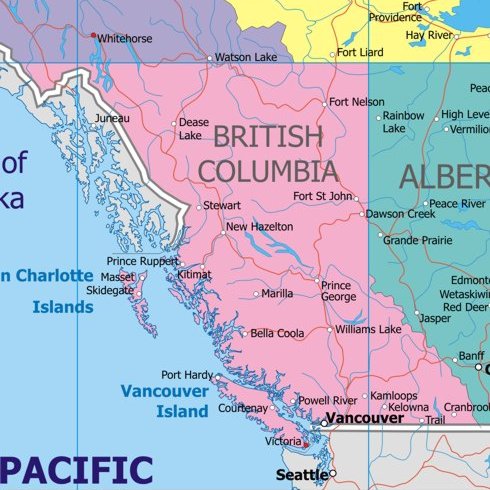
Copyright - [[Trail Canada]]
In late 2008 through to early 2009 I visited British Columbia, Canada.
While there I visited Colleges and spoke to welding instructors and welding industry people.
What I saw was impressive and interesting - particularly regarding the thought: could this be a model to rebuild vocational training in Britain
British Columbia is the Western side of Canada. Its coast is to the Pacific Ocean.

Time difference to GMT is -8hours (so British Columbia is 2/3rds of the way to the opposite side the world from Britain)
The area I visited is about on the same Latitude as Southern England. The climate is the (notorious!) Pacific North-West climate - temperate and with a lot of rain. They have "temperate rain forest".
This is a mixture of explanations made to me, partly backed up by observations.
The BC economy has the "resource" industries:
Demographically, the Southern tip of Vancouver Island has become a popular retirement area for Canadians, having the mildest climate in all of Canada. Huge areas of retirement Condominiums have risen around Victoria in the last 25years. With the supporting "service industry", this demographic change is diluting away from the previously dominant rugged outlook of the loggers, miners, fishermen and the "living in the wilds" types.
This is a "Declaration of Interests". I feel indepted to Trade training in the Province of British Columbia. This influences my perception of the courses and activities I describe here.
In only 2 years since going back into construction, I've risen to often being counted as a member of the senior team. I credit an essential ingredient of this rapid rise as the help I have received from North America. Basically, the overall path of my life has moved off in a very positive direction due largely to this North American help. However - the biggest surprise was yet to come, with this visit to British Columbia straddling the 2008 to 2009 Christmas / New Year season, from which I am just returned.
The accumulating influence came in two main forms:
| Britain | North America | |
|---|---|---|
| Rutile "6013" | Univerally used - few exceptions. | Almost never used |
| Basic "7018" | Regarded as specialist - associated only with "low hydrogen" applications | General purpose rod |
| Cellulosic "6010" | "They are only for root-running pipeline, using the 'dragging' technique. They have no other application." | General-purpose rod where you want fast-freezing and/or powerful penetration |
The "associated skills" have had a purely positive effect on my career progression.
Here is "Boilermaking Manual" of the Province of British Columbia's Apprentice training program, sent to me some time ago. The effect it had was to draw together what knot-tying skills I had and launch me along the development path of the Trade skill of "Rigging" (the largest reason for my "senior" standing when the need for these skills arise on construction sites).
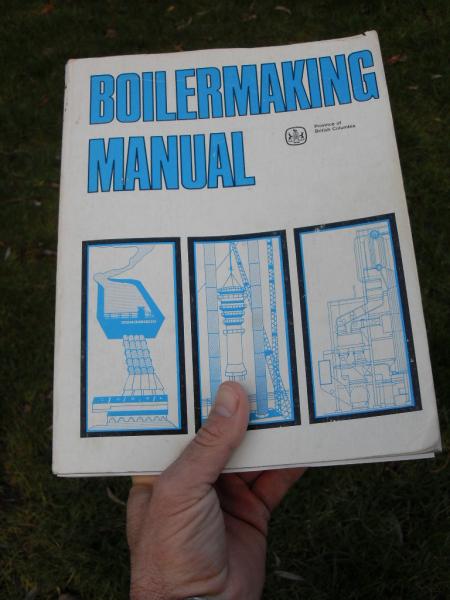
Examples of influence the Manual has had.
This is a quick summary of the features which make this course look to me like the complete answer to vocational training in Britain.
They do exist markedly, are very important in meeting local industry needs - and accomodate within the uniform Province-wide syllabus. I will return to this point after showing where are the colleges I visited.
I credit this outline to the University of Fraser Valley [[welding program]] webpage.
The course is listed with more detail by Vancouver Island University at Nanaimo ("Malaspina College") [[here]] and [[here]].
The course has three levels of accomplishment. These are Levels "C", "B" and "A", in ascending skill order. Welders usually progress through these over a period of many years, accumulating considerable experience in regular employment before judging the time as right to return to college for the next step. This is in fulfilling a long-term career progression plan.
The Level "C" college training is 7 months full-time
The durations in college become shorter for each of the higher levels. Level "B" takes 5 months (???), Level "A" 3 months (???).
The course is popular and well-subscribed - so there is something right about this, viewed in entirety of what seems to be achieved for Trade careers in British Columbia (and Canada; BC welders include familiar fixtures in other Provinces in career path options - eg. pipeline welding in the tar-sands fields of Alberta after passing BC Level "B")
Matching the course progression are a number of familiar career paths. For instance after completing Level "C", welding in a shipyard or a fabrication shop would be appropriate experience. Working in the Alberta oilfields requires a BC Level "B" - and is a suitable experience option for Level "B" course graduates. A much more extensive discussion of career options at levels is possible.
This is the Log Book which you receive after passing the Level "C" college course (you still have the level "C" work experience ahead of you before you pass level "C"). In it you log all your career as a welder.
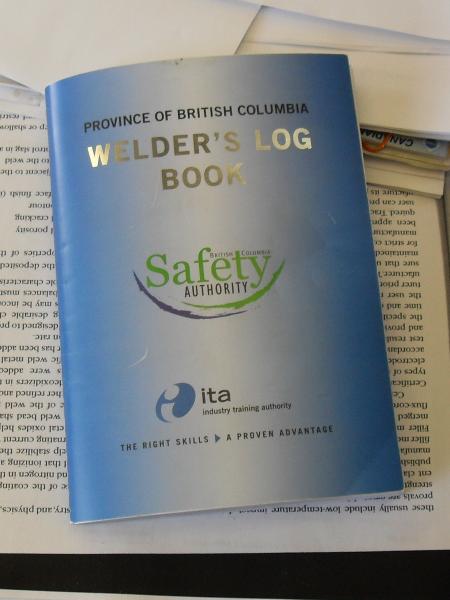
This is a random selection of the contents of a logbook
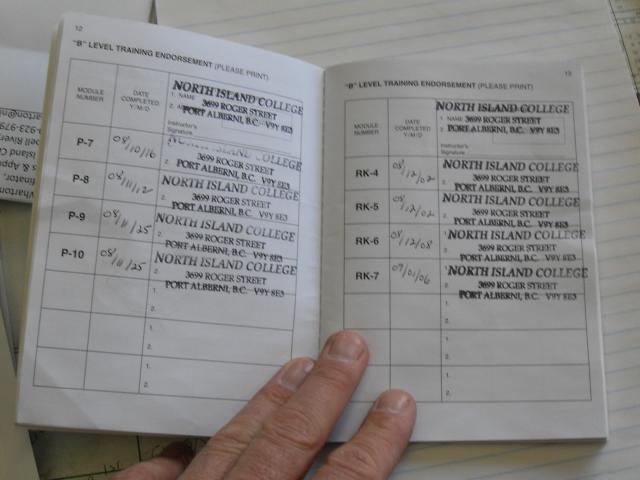
One point made by a practicing commercial welder-fabricator "sub'ing" (filling-in for an absent lecturer) at a college is that no company engages in the full range of welding activities necessary to become a fully-fledged welder. An apprentice tied to one company therefore cannot obtain a full skill-set.
In the BC modular welding course with "blocks" of intense training and staged career progression, the welder develops a wide skill range by selecting employment. This is in the flexible and changing market of the various commercial activities in the various geographical locations, made possible by good training supplying qualified welders.
A very interesting and excellent provision in the rules of the BC Welder Training Program.
If you do not have a BC welding qualification (Levels "C", "B" or "A") but believe you have the ability of that particular level, you can "challenge" the qualification. That means, you take the end-of-course exam and make the weld test-pieces of the course. If you pass at both of these and have the requisite work experience as specified for completion at that level, you become a holder of BC welder qualification at that level.
This is commonly invoked in two familiar cases:
The former category tend to find that their skills are only a part of the spectrum of skills in the BC welder qualification. They commonly enrol at a college and obtain the qualification, often at an accelerated rate from being able to quickly dismiss the parts of the course they are already skilled in.
"Arriving in the Province" challengers with high skills, eg a pipeline welder from Manitoba, might be able to challenge through the "C", "B" and "A" levels consecutively in a short space of time.
A regional reason for block full-time attendance on the welding course is that travel distances in Canada are often large. Such as would preclude part-time attendance by way of after-work journeys.
A very reasonable point. There are a minority of people who are excellent welders but do not intellectually command the abstractions represented by orthographic drawing and geometry. There is a concentration of these people in steel construction. They are drawn to this field where necessary theory attaches to a large matrix of knowledge of practice. Denying this rewarding career due to something extrinsic to their ability to work as a welder is undesirable. My suggested solution - there should be a restricted welding-only-endorsed variant of the qualification to cover these cases.
This is a largely historical and defunct objection.
It was represented to me that two categories of employers used to complain that they only needed people to do welds These were the large mills of the logging and paper industries and big shipyards.
However, harder economic times, evolutions in the workplace, etc have brought the mills around to wanting welders with both the "headline" and "adjunct" skills. Regarding the big shipyard employers, as there is no "job for life" guarantee there cannot be a welding-only training policy.
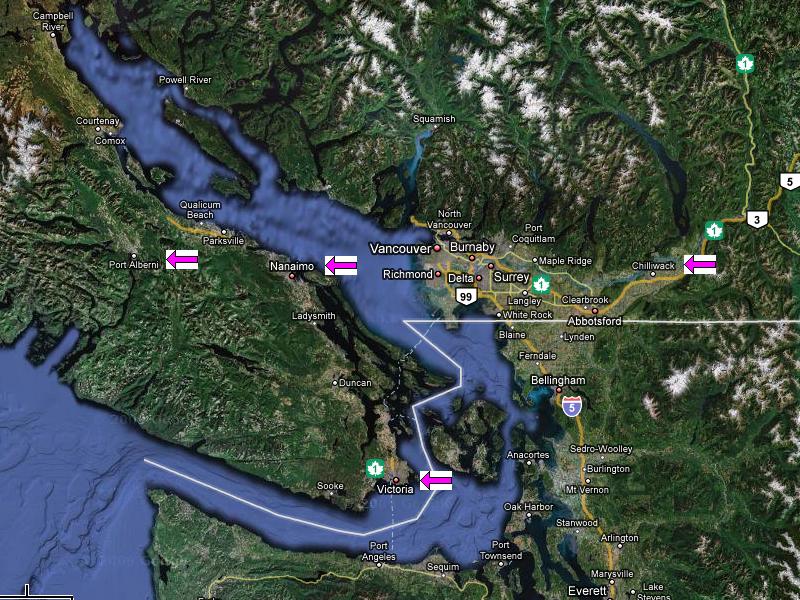
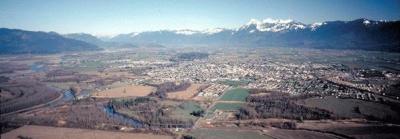 Chilliwack
Chilliwack

 Port Alberni
Port Alberni

 Nanaimo
Nanaimo
 Victoria
Victoria
The interesting finding from visiting several colleges in BC is that, in spite of the necessary "uniform syllabus" there are indeed very strong local variations in what is taught!
The colleges get "coverage" for this at Provincial level. Consultative bodies with Statutory footing have local Industry representatives who assert their local training need.
Taking the example of Aluminium MIG welding:
Another local variation is how much emphasis is put on the "rigging" part of the course.
The exception was Camosun College in Victoria, where most students are "welders" in big shipyards and have little need of rigging skills - whereas the need for skill at gouging techniques (air-arc gouging, oxy-flame gouging) for thick plate joint preparation leads to emphasis on this part of the syllabus.
The other colleges visited - Chilliwack, Port Alberni and Nanaimo - strongly teach rigging skills, as they provide to smaller local companies and to operations "out in the wilds" - both types needing the full range of "adjunct" skills - blueprint reading, fabrication and rigging - to be possessed by their welders.
Rigging is a special interest area of mine - which is why I use this subject to show why training in some of the basics of the "adjunct" skills a welder uses is so important.
There is a "rigging equipment locker" with wire-rope slings, ropes, come-alongs, block-and-tackle, strops, beam-clamps, D-shackles, jacks, chain-blocks and others.
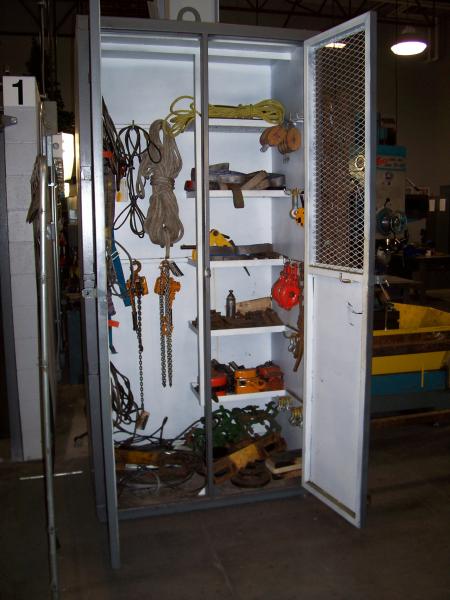
This jib crane is in the yard.
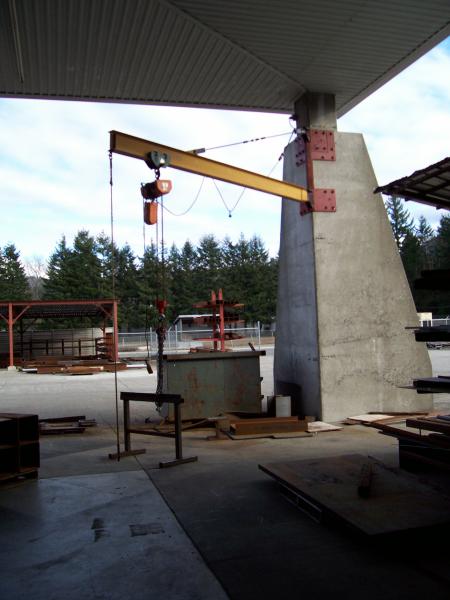
It has some utility to the welding department staff for handling loads. It is however mainly provided as a teaching tool, so students can get experience of moving and controlling loads far heavier than could be moved by manual lifting. In other words, "you cannot cheat the learning objective" - this is about working in the real domain of mechanical lifting devices.
Here is a pair of tubular components with flanges which present at a 45degree angle of slope.
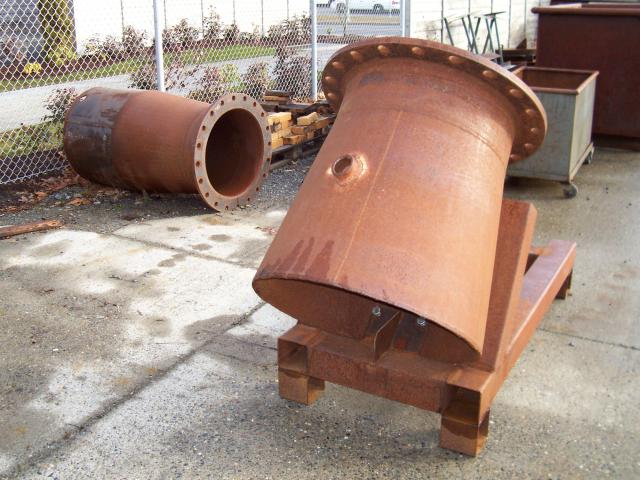
As a learning exercise, the students assemble it by matching up the flanges and bolting up the flange joint. The tubular pieces are each far too heavy to lift manually, so the students must use lifting equipment, particularly chain-blocks, with accurate positioning of components. The exercise gives students some experience of the realities of erecting equipment on site.
This "site box" serves as the equipment locker for the rigging equipment used to teach the rigging skills of the welder training course at this college.
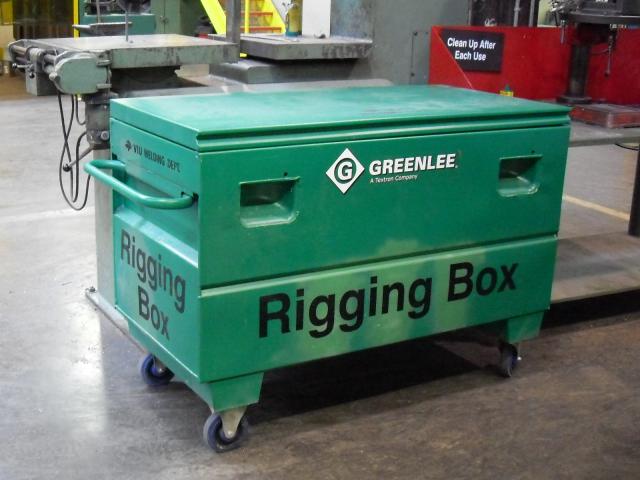
Here is what is inside the rigging equipment "goodies chest".
There are the usuals there - chain-blocks, come-alongs, strops of fabric and wire-rope, crane-hooks, ratchet straps, bridle-sets (pair of chains with hooks off one hoop), shackles, plate-lifters
No photo taken - the diagram shows this simple triangulated bracket from which a chain-block can be suspended.
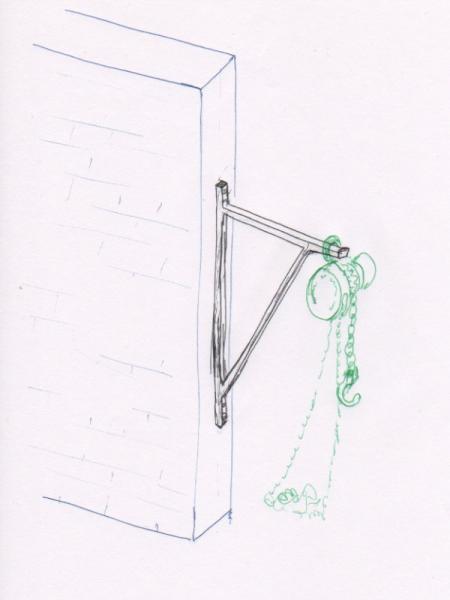
This enables the students to experience using a chain-block (the most frequently used mechanical lifting device for maintenance and small-scale steel-erection tasks) and the way loads are attached to the hanging hook of the chain-block - direct hooking opportunities and using various strops and chains.
So this apparently simple provision meets a lot of needs.
To comply with the syllabus, Camosun College is getting some rigging equipment - such as fits in a locker. Historically, Camosun College, training shipyard welders, hasn't seen a need to teach rigging. The exception compared to the other colleges visited.
The point is to show how crucial the "adjunct skills" are to the day-to-day work of a "welder".
The section taps into a very personal view of what developing a skill has done for me and my career path. I believe this: if you do not get taught the basics of a skill you do not get entrained in that skill's use and will not develop it, whereas someone taught the basics will get included in the use of that skill and will develop it until they become an accomplished practitioner themselves.
I present two example where I have used the skills of rigging to do day-to-day work in steel construction.
I could equally extensively treat fabrication skills and reading blueprint skills regarding the same point - which is unnecessary as the overall point is already made.
With only your toolbox and what you have in it, these steels need to be pulled sufficiently into line that you can insert a podger (N.Am - "spud wrench") through the bolt holes to finish off the aligning.
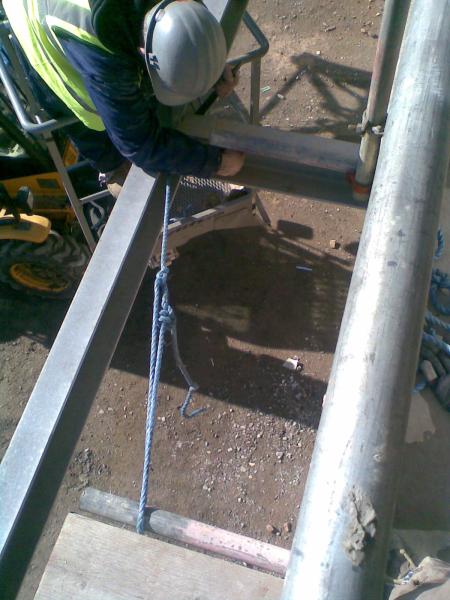
However, in cases like this the friction of the rope as it is drawn passing through the rope loops defeats a lot of the 3-to-1 mechanical advantage a wagoner's hitch could deliver. Apropos of this (previously mentioned):
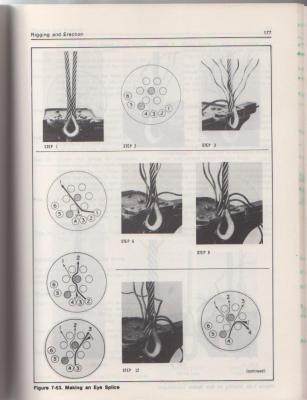
Inserting "thimbles" into a modified Wagoner's Hitch occurred to me as a solution to lower friction and obtain close to the 3-to-1 M.A. offered by having 3 parts of the system.
Here is my "Tofino modification of a Wagoner's Hitch".
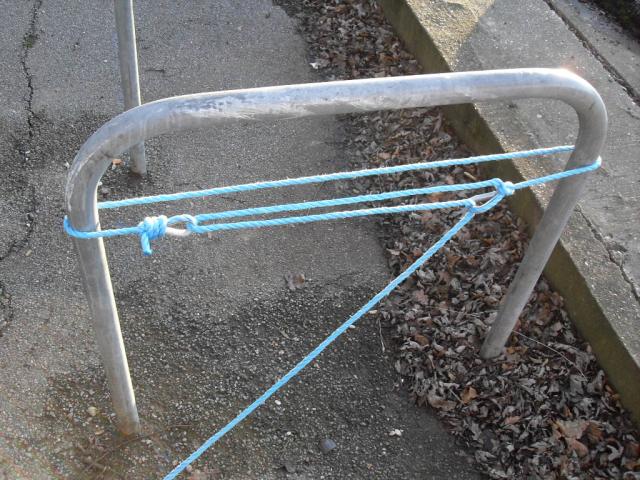
The sliding friction of the rope in the thimbles is indeed very low. The Hitch tensions up so much under a person's pulling strength that the back strand of the modified Hitch plucks like a guitar string.
These steel stairway/landing units needed additional restraint to prevent forward (and backward) movement. The delivery was a three day non-stop shuttle from workshop to site by two trucks, to fit-out a 10-storey cast concrete stairwell shell in one continuous crane-slot. This photo shows the initial solution.
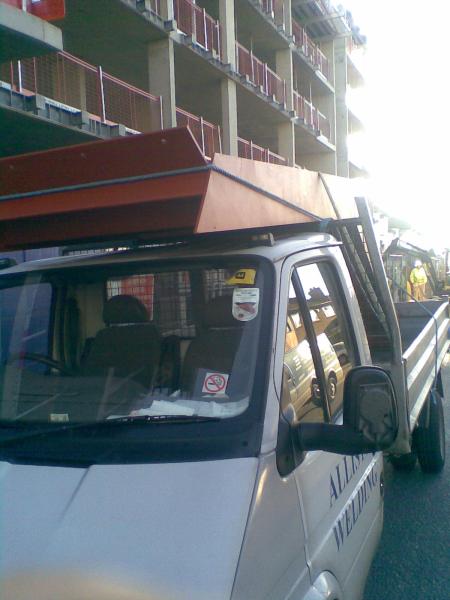
The illustration shows subsequent and final specification for fastening the load.
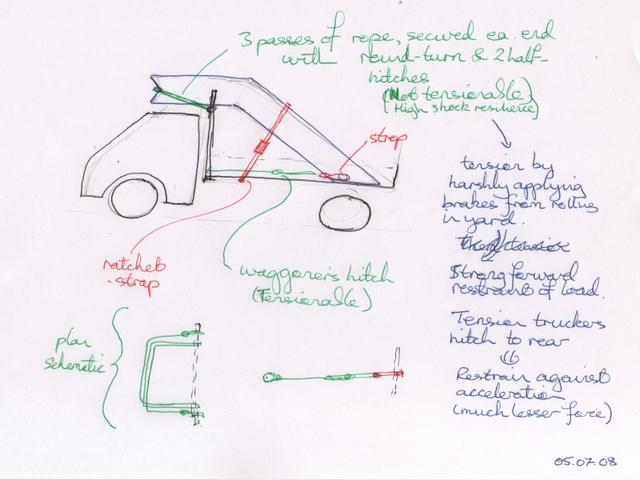
The forward restraint of the stair assembly is most crucial - the brakes of the truck can cause about 1G of deceleration force; also for the worse case of a collision in congested London traffic. So the solution uses three loops of a rope around the front of the stairway/landing unit, using its re-entrant angle feature for location. The ends of the rope are secured around the bolster with a "round-turn and two half-hitches". However the intermediate wraps at the bolster are only a half turn so the rope tension can redistribute by slippage. As explained, this knot is untensionable and is brought into tension by jabbing the brakes at the yard, sliding the load against the ropes. The rearward restrain only needs to hold against the very limited acceleration provided by the motor moving this heavy load. The rear wagoner's hitch, tensioned after sliding the load up against the front loops, holds the stairway thus. The ratchet strap, rated to 5Tonnes tensile force, was also tensioned up at this point. Forcefully "slaloming" the truck side-to-side with this load on a stretch of private road leaving the yard showed no concerns for proceeding onto the public highway.
Proverbially, "not all in the garden is rosy". Not all officialdom has positive sentiments towards the BC welding course. Where these attitudes were found, the desire is to shorten and cheapen the course.
Officials taking this outlook faced two uniformly held unmoving positions
To an extent the colleges had "coverage" from the "partner" employers with positions on the Statutory industrial training consultative body.
The attempted means to force shorter cheaper courses was to bring in private colleges. Focusing on "torch in hand" skills, they promised students who enrolled on these courses would obtain the BC "C" level course in 4 (?) months. They uniformly made little training progress and the Government department ended up having to pay the fees of these students to pass through the Provincial colleges. At present, the issue has gone quiet.
The "BC welder training course" is popular - of that there is no doubt.
Taking the case of Aluminium (N.Am. - "Aluminum") welding:
Here is a pitcure of a British student with a weld test-piece he has made.
* PICTURE OF ADAM? *
At Malaspina College in Nanaimo I proceeded out into the stockyard and encountered this.
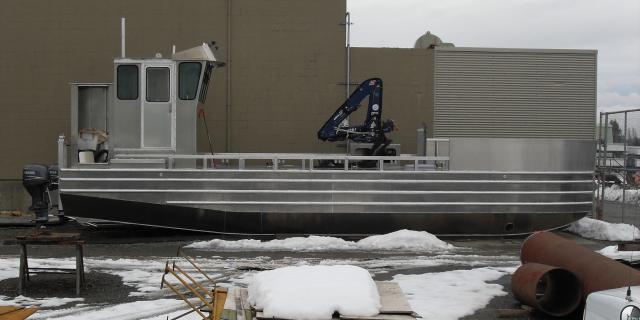
It is a completed Aluminium-hull boat for a scientific research organisation at the North end of Vancouver Island, built at the college * BY THE LECTURERS AND STUDENTS? *.
One can get an optimistic feeling from seeing the BC welding program in action. As this is broadly representative (other colleges had other activities and projects), I provide more details, which carry forward this positive sentiment.
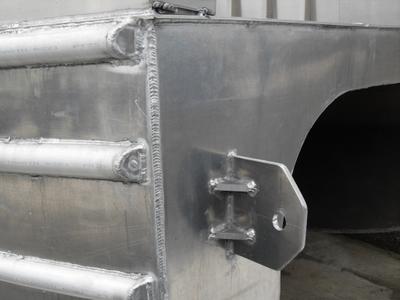
|
Al-MIG welding
Twin-hull design can be seen |
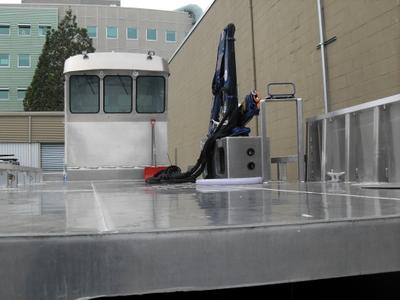
|
Commercial crane-arm installed on deck
(Al welding workshop in background extends all along stockyard to LHS) |
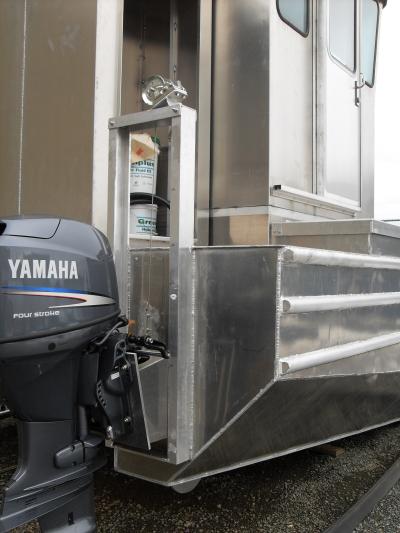
| Charitable organisation gets boat; college students get career-developing experience |
It is fairest to comment - Malaspina College has an [[Aluminum Boat Building]] program.
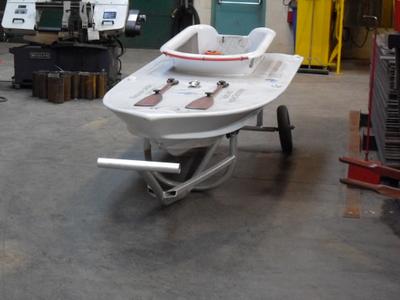
|
Light aside - "bathtub racing". Powerful outboard motor and absurd
courses across of Strait of Georgia. Bit like "Star Wars" "Pod
racing" but competitors generally survive - albeit spitting out
seawater and a bit roughed-up.
UK colleges try to have some fun - some do dirt-track go-kart racing, building their own karts and taking them to competitions |
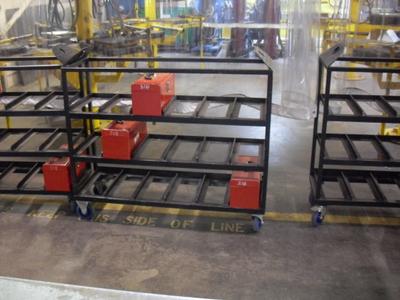
|
More seriously.
Each toolbox represents a student. As students are in for blocks of time (5days/week full-time), at this college each gets assigned a toolbox with tools, returned at the end. |
The course has a large number of skills to be mastered at each level. The combinations of the parameters
So if one is familiar with a UK welding courses the question is going to be - how rapidly do the students get through the course with its "vast" amount of work? - and how do they manage it?
The answer is that a lot more tests are done and this is possible because the progression rate is faster. The BC learning rate is the "correct" rate and the UK learning rate is "artificially restricted".
This is my understanding, from having been a student in UK welding courses (3 different colleges), from working as a welder in commercial construction activity and from welding theory supported by this foundation of welding skill.
In UK courses specified test welds are often non-commercial cases and make specific use of being jammed into a barely controllable corner of the domain of feasible and/or stable welding conditions. The achieved effect is to limit the consumption of steel and welding consumables. Students have to spend a large amount of time, practicing with scrap, to get passable welds. And each weld takes a long time to complete. Plus many failures results in a much time testing and re-testing - and while the student is sawing, filing, nick-breaking and etching samples, the cost per time to the college is negligible.
To an extent it is true that welding students trained under there conditions will find working with the correct welding consumables and conditions much easier later. The problems are
The entire situation in the UK can be understood by taking the case of the standard test for SMA welding a horizontal-vertical T-fillet. The standard specification is
The following table explains the interaction of variables which make this weld problematic:
| Parameter | Stipulation | Comment |
|---|---|---|
| Welding rod type | Rutile - "6013" |
(i) Least penetrative rod - it hasn't got much fusing power to fuse a fillet corner
(ii) Rutiles arc to one side and trap slag very readily in the constricted space of a fillet corner |
| Welding rod size / plate thickness | 2.5dia welding rod / 6mm thick plate | At ~90A maximum current the 2.5dia rod does not have the power to fuse 6mm plate (40A/mm -> 240A max; 90A way too low) |
| Fusion stipulated | Full fusion of the fillet corner | Commercial codes expect the weld to fuse up to fillet corner - this requirement is excessive and unrealistic |
In practice at UK welding colleges, the students are being exhausted by their second-by-second efforts to overcome the problems of running sound welds in these unrealistic conditions, compounding the slow-down of progress.
The students are using commercial-practice sized welding consumables and commercial conditions. Both
Furthermore, the welding consumables are generally top-name brands. For example, I saw "Lincoln Excalibur" for 7018 Basics and "Lincoln 5P+" for 6010 cellulosics. Which advantages the student in learning the core skills rapidly, through well-behaving welding processes.
Regarding cost in running the courses, I am assured that the welding departments in the colleges rely upon donations to part-supply their materials consumption. Donation is obvious in the stockyards and stockrooms of the colleges. It apprears there is a well-developed cycle where skilled welding course graduates feed into local commercial companies then able to do varied high standard work, out of which the companies are able to donate varied out-of-code and offcut materials to colleges.
Quoting [[this page]] from Vancouver Island University at Nanaimo:
"As a level C ticket holder you could find work in a shipyard, fabrication shop, or with the Department of Highways. With a level B ticket you are eligible for work in a sawmill or anywhere that requires a welder who is qualified to do run-off pressure procedures. And upon completion of level A you will be highly qualified to work in almost any location. Upon passing your Inter-Provincial assessment you will be eligible to work in most provinces in Canada, and many countries around the world."
The BC Level "B" qualification is regarded as high enough to entitle the holder to go for the Inter-Provincial "Red Seal" which enables that welder to work in other Provinces in Canada.
A common progression route for the BC welders passing BC level "B" is to work in the oil fields of Alberta. BC level "B" is held to be equivalent to an Alberta "journeyman". As was noted previously - the Modular course not only makes Vocational training possible in a fluid labour market but also seems to have turned it into an advantage for delivering complete Vocational development through progression stages.
R. Smith - February 2009